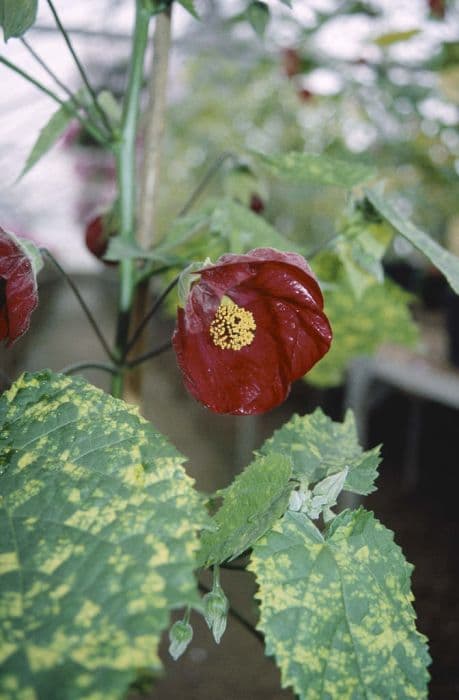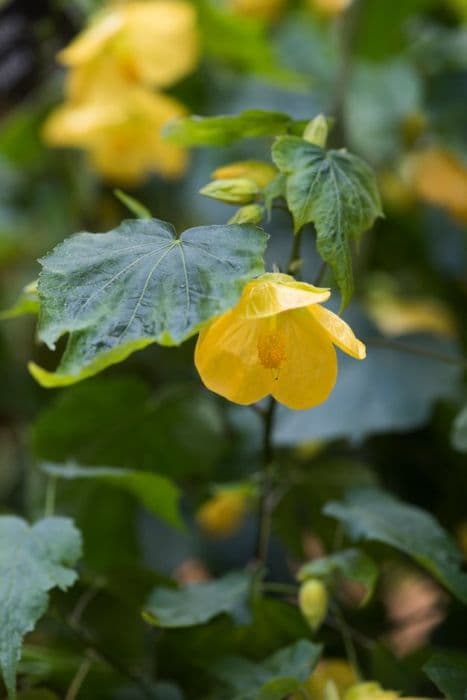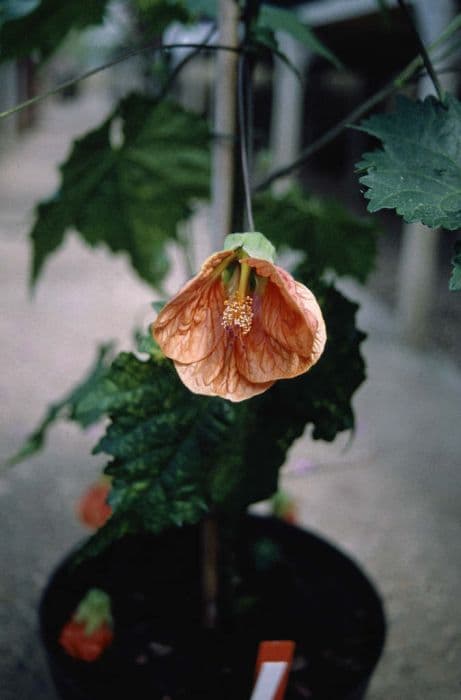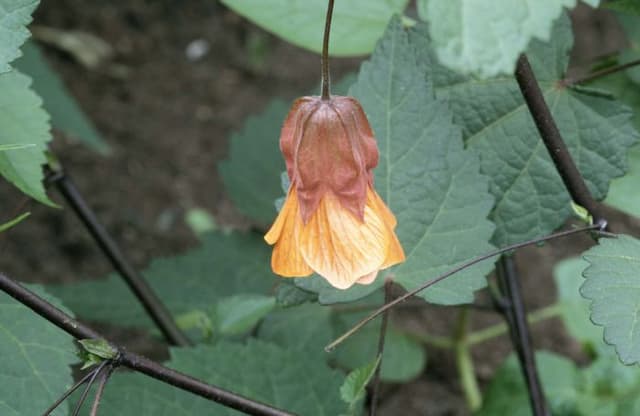Rose of Sharon Hibiscus syriacus 'Shintaeyang'

ABOUT
The Hibiscus syriacus 'Shintaeyang', more commonly known as Rose of Sharon, is a showy plant characterized by its abundant and vibrant blooms. Its flowers are large and trumpet-shaped, featuring an eye-catching combination of colors—usually a mix of pink, red, and purple hues, with a prominent, contrasting center that often displays a different shade or a burst of stamen that adds to its ornamental appeal. The foliage of the Rose of Sharon is equally attractive, composed of medium to dark green leaves that have a glossy texture and a slightly toothed edge. The leaves are broadly oval in shape and point towards the tip, adding a lush backdrop to the floriferous display. During its blooming period, the Rose of Sharon becomes a focal point in any garden-setting thanks to its prolific flowering habit. Its blossoms have a papery, delicate quality and can appear in singles or doubles, depending on the cultivar. When in full bloom, the plant radiates with color and can attract pollinators such as bees, butterflies, and even hummingbirds. The overall shape of the plant is upright and vase-shaped, creating a graceful silhouette that integrates well into mixed borders, hedgerows, or as a standalone specimen. The branches are slender and may have a slightly arching quality, giving the plant a poised but relaxed posture. The structure of the Rose of Sharon lends itself to being an elegant addition to both formal and informal landscapes, with its blooming spectacle providing visual interest from late summer to early fall.
About this plant
 Names
NamesFamily
Malvaceae
Synonyms
Rose Of Sharon, Althea, Hardy Hibiscus, Syrian Ketmia, Shrub Althea
Common names
Hibiscus syriacus 'Shintaeyang'
 Toxicity
ToxicityTo humans
Rose of Sharon is generally considered to be non-toxic to humans. However, as with any plant, individual sensitivities can vary, and ingesting any part of the plant may cause discomfort or an allergic reaction in some people. There are usually no significant symptoms of poisoning associated with Rose of Sharon, but if significant portions are ingested, it might lead to gastrointestinal upset, such as nausea, vomiting, or diarrhea.
To pets
Rose of Sharon is considered to have a low level of toxicity to pets. However, it can still cause some mild to moderate digestive discomfort if your pet consumes parts of this plant. Symptoms of poisoning in pets might include vomiting, diarrhea, nausea, and general gastrointestinal upset. If you suspect your pet has ingested a substantial amount of Rose of Sharon, it is advisable to contact your veterinarian.
 Characteristics
CharacteristicsLife cycle
Perennials
Foliage type
Deciduous
Color of leaves
Green
Flower color
Varies
Height
8-12 feet (2.4-3.7 meters)
Spread
6-10 feet (1.8-3 meters)
Plant type
Shrub
Hardiness zones
5-9
Native area
Asia
Benefits
 General Benefits
General Benefits- Ornamental Value: Hibiscus syriacus 'Shintaeyang', commonly known as Rose of Sharon, offers striking flowers that add aesthetic value to gardens and landscapes.
- Attracts Pollinators: The plant's vibrant flowers attract bees, butterflies, and other beneficial pollinators, supporting local ecosystems.
- Drought Tolerance: Once established, Rose of Sharon is quite drought-tolerant, requiring less watering and maintenance compared to other garden plants.
- Versatility: This shrub can be trained into various forms, such as tree standards, hedges, or used in mixed borders for landscape design flexibility.
- Long Blooming Period: Rose of Sharon has a long flowering season, from mid-summer to early autumn, providing continuous color when many other plants have ceased blooming.
- Wildlife Habitat: It provides shelter and food for wildlife, including birds that may feed on the seeds in late summer to winter.
- Adaptable: It is adaptable to a variety of soil types, though it prefers well-drained soils, and can tolerate urban pollution, making it suitable for city environments.
- Privacy Screen: When planted in groups, Rose of Sharon can serve as a living privacy screen or windbreak.
- Cooling Effect: The foliage of the shrub can provide cooling shade to smaller garden spaces during hot summer months.
 Medical Properties
Medical Properties- Anti-inflammatory: The leaves of the plant are reported to have anti-inflammatory properties.
- Antipyretic: It may help to reduce fever, although this use is not widely documented or scientifically proven.
 Air-purifying Qualities
Air-purifying QualitiesThis plant is not specifically known for air purifying qualities.
 Other Uses
Other Uses- Ink and Dye: The flowers of the Rose of Sharon can be used to make a natural dye for fabrics, paper, and even cosmetics. The deep colors of the blossoms concentrate when boiled and can be used to impart varying shades to materials.
- Food Coloring: Similarly, the petals can be utilized as a natural coloring agent in food, offering a vibrant tint to recipes without artificial chemicals.
- Edible Delicacies: The blossoms of the Rose of Sharon are edible and can be added to salads for a decorative touch, or crystallized with sugar for cake decorations.
- Traditional Musical Instruments: The wood is sometimes used in Korea to make parts of traditional string instruments, taking advantage of its fine grain and texture.
- Eco-Friendly Soap: The extracts from Rose of Sharon leaves and flowers can be used to create an eco-friendly soap with minimal environmental impact.
- Culinary Garnish: Fresh or dried petals can be used to garnish desserts and cocktails, adding a floral note and elegance to presentation.
- Flower Arranging: The unique form and long blooming period make the Rose of Sharon a favorite in flower arrangements, altar decorations, and as part of bridal bouquets.
- Landscape Design: The shrub can be trained into different shapes, making it versatile for topiary or formal landscape designs beyond the typical hedging or ornamental uses.
- Handicrafts: Dried Rose of Sharon petals and wood can be incorporated into handmade paper or used as a natural element in jewelry making.
- Interfaith Symbolism: The Rose of Sharon's various colors and forms can be used symbolically in interfaith practices, representing unity or harmony across different cultural ceremonies.
Interesting Facts
 Feng Shui
Feng ShuiThe Rose of Sharon is not used in Feng Shui practice.
 Zodiac Sign Compitability
Zodiac Sign CompitabilityThe Rose of Sharon is not used in astrology practice.
 Plant Symbolism
Plant Symbolism- Beauty: The hibiscus flower is often associated with beauty due to its large, colorful, and eye-catching petals.
- Glory: In South Korea, where Hibiscus syriacus is the national flower known commonly as Rose of Sharon, it symbolizes glory and is celebrated in national emblems and symbols.
- Femininity: With its delicate form, the hibiscus can represent the ideal of femininity, often associated with gentleness and attractiveness.
- Immortality: The Rose of Sharon has a reputation for being able to survive harsh conditions, symbolizing persistence and the eternal nature of life.
- Love: Hibiscus flowers are often given as gifts to express romantic interest and deep passion due to their vibrant and alluring appearance.
 Water
WaterThe Rose of Sharon should be watered deeply and thoroughly, allowing the soil to dry slightly between waterings. In absence of rainfall, water the plant about once a week with approximately 1 to 1.5 gallons of water, depending on the soil conditions and weather. During hot, dry periods, water twice a week to keep the soil evenly moist. Be careful not to overwater, as Rose of Sharon does not like soggy soil. Adjust the watering frequency and volume according to the season and the plant's growth stage, reducing water in the fall and winter when the plant is dormant.
 Light
LightThe Rose of Sharon thrives in full sun to partial shade. For the healthiest growth and best flowering, position the plant in a spot that receives at least six to eight hours of direct sunlight daily. If you live in an area with very hot summers, a location with afternoon shade can help prevent heat stress.
 Temperature
TemperatureRose of Sharon is hardy in a wide range of temperatures and can survive minimum temperatures of around -20°F for short periods, but ideally, it should not be exposed to temperatures below 0°F. The ideal growing conditions involve warm summer temperatures, typically between 60°F and 90°F. It's heat tolerant and can endure the high summer temperatures without issue.
 Pruning
PruningPrune the Rose of Sharon to maintain shape and encourage healthier blooms. It should be pruned in late winter or early spring before new growth begins. Pruning not only helps to shape the plant but also promotes the growth of larger flowers. Removing dead wood and thinning out crowded branches every few years will help to improve air circulation and plant health.
 Cleaning
CleaningAs needed
 Soil
SoilRose of Sharon thrives in well-draining, loamy soil with a pH between 6.0 and 7.5. A mix of two parts loam, one part peat moss, and one part perlite is ideal, providing both aeration and moisture retention.
 Repotting
RepottingRose of Sharon, being a shrub, does not need frequent repotting. It is typically planted outdoors; however, if grown in a large container, it should be repotted only when it outgrows its current pot, usually every 2 to 3 years.
 Humidity & Misting
Humidity & MistingRose of Sharon prefers average to high humidity levels; however, it is quite adaptable to different environments and can tolerate both dry and humid conditions without significant issues.
 Suitable locations
Suitable locationsIndoor
Ensure bright light, well-draining soil, and room to grow.
Outdoor
Plant in full sun, well-draining soil; prune after flowering.
Hardiness zone
5-9 USDA
 Life cycle
Life cycleHibiscus syriacus 'Shintaeyang', commonly known as Rose of Sharon, starts its life as a seed, which upon germination in early spring, develops a root system and shoots that grow into a small sapling. The sapling matures over several years, developing woody stems and branches that lead to a shrubby, upright form. Every year from late spring to fall, the mature plant blooms with large, trumpet-shaped flowers that can be various colors, often with a different color center or eye. Following pollination, typically by bees and butterflies, these flowers produce dry seed pods that split open when mature to release seeds for the next generation. During the fall, the plant starts to go dormant, shedding leaves as it prepares for winter, conserving energy for the next growing season. With appropriate care and conducive growing conditions, Rose of Sharon can live for many years, sometimes several decades, repeating this annual cycle of growth, flowering, and dormancy.
 Propogation
PropogationPropogation time
Spring-Early Summer
The Hibiscus syriacus 'Shintaeyang', commonly known as Rose of Sharon, can be effectively propagated through semi-hardwood cuttings during the late summer. To propagate Rose of Sharon, cut a stem of about 6 to 8 inches (15 to 20 centimeters) in length from a healthy branch, ensuring there are at least two nodes on the cutting. It’s important to make the cut just below a leaf node. Strip the cutting of all but the top two or three leaves to minimize water loss. Dip the cut end into rooting hormone to encourage root growth before inserting it into a pot filled with a well-draining potting mix. The cutting should be kept moist and placed in a warm spot with indirect sunlight until roots develop, which typically takes several weeks. Covering the cutting with a plastic bag can help retain humidity, but ensure there is still adequate air circulation to prevent mold growth.





![Abutilon [Yellow Trumpet]](/_next/image?url=https%3A%2F%2Fplants-admin.emdemapps.com%2Fimages%2Fplants%2F%2Fimages%2F604b5caa8b4fb.png&w=640&q=75)


